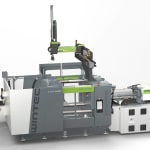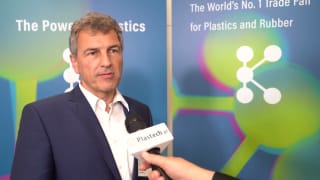
At K 2025, Engel is set to demonstrate an integrated production cell from its Wintec brand aimed at automotive interior applications. The exhibit is built around a t-win 6500 two-platen injection moulding machine with 6500 kN clamping force equipped with MuCell physical foaming. In this setup, nitrogen or carbon dioxide is introduced into the melt, and a screw geometry optimised for MuCell ensures uniform gas distribution to create a fine cell structure in the mould. The approach reduces part weight and material consumption while maintaining dimensional stability and visible surface quality. The displayed application is a B‑pillar trim made from mineral-filled polypropylene, moulded in approximately 50 seconds. The part has a shot weight of around 290 g and uses Sabic’s polypropylene grade F9015 in combination with a tool from Simoldes. According to Engel, the cell combines material efficiency with stable processing and automation to support cost-effective production of complex interior components.

30% less material, same stability: MuCell technology enables cost-efficient lightweight design for automotive interiors.
Machine, automation and control
The Wintec t-win features a robust two-platen design. Short-stroke pressure pads support short cycles, while a synchronous locking system and a servo-hydraulic drive enable fast and energy-efficient operation. A compact footprint and optimised maintenance access are intended to reduce operating costs and facilitate integration on the shop floor. The cell is controlled via the C3 unit, which provides clear process management with high performance.
Part removal is handled by a fully integrated viper 20 linear robot. Close integration of robot and machine within a single control system synchronises motion sequences to stabilise processing and shorten cycle times, reducing operator workload and supporting consistent part handling.

Compact, powerful, and efficient: The Wintec t-win 6500 with two-platen technology reduces production costs while ensuring high part quality.
Digital assistance and process stability
The cell incorporates Engel’s digital assistance suite. iQ hold control supports setup by optimising the holding pressure profile for the specific part and material, automatically determining holding time and pressure to compensate for filling and shrinkage. This aims to improve dimensional accuracy, surface quality and scrap rates, particularly with complex geometries.
During production, iQ weight control monitors each cycle, analyses filling behaviour and adjusts the switchover point in real time to maintain consistent part weight despite fluctuations in melt viscosity. Engel reports that the function can reduce scrap by up to 85 percent and enhance process reliability when batch properties vary.
In addition, the iQ process observer continuously tracks machine and process parameters across the injection moulding sequence, detects deviations early and provides actionable recommendations. The objective is to further stabilise processing, maintain part quality and increase system productivity over time.
Brand positioning and exhibit
Engel focuses on tailored solutions for high demands in precision, efficiency and digitalisation, while Wintec supplies cost-optimised standard machines with Engel DNA for reliable, smart applications. Both brands emphasise high quality, with Wintec drawing on Engel’s engineering expertise.
The integrated t-win 6500 MuCell cell will be shown at K 2025 in Düsseldorf, Hall 15, stands B42 and C58.




